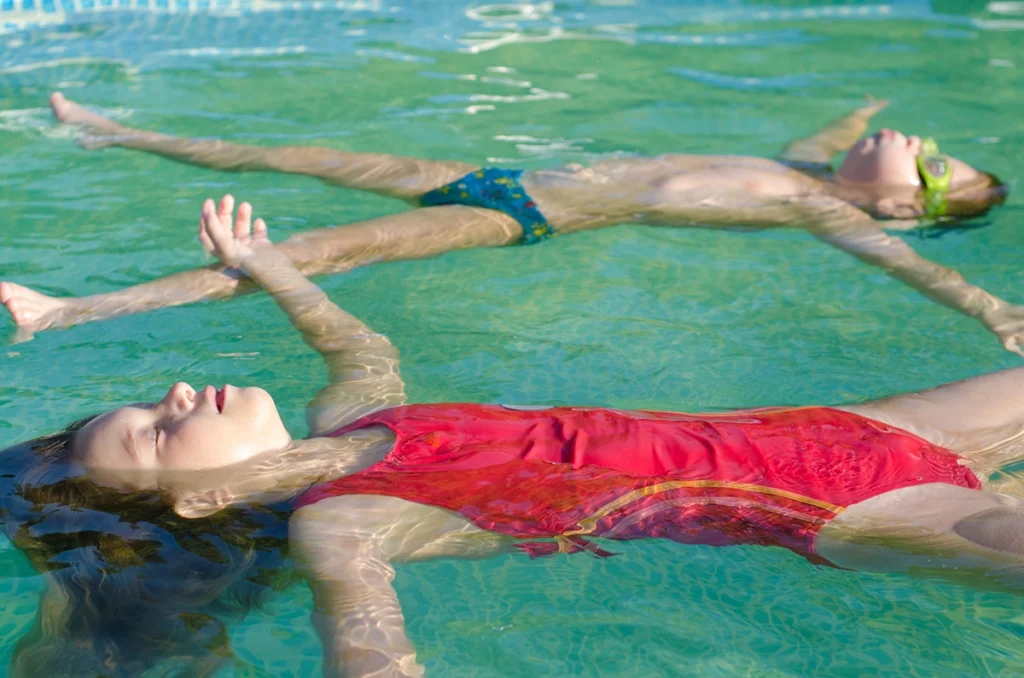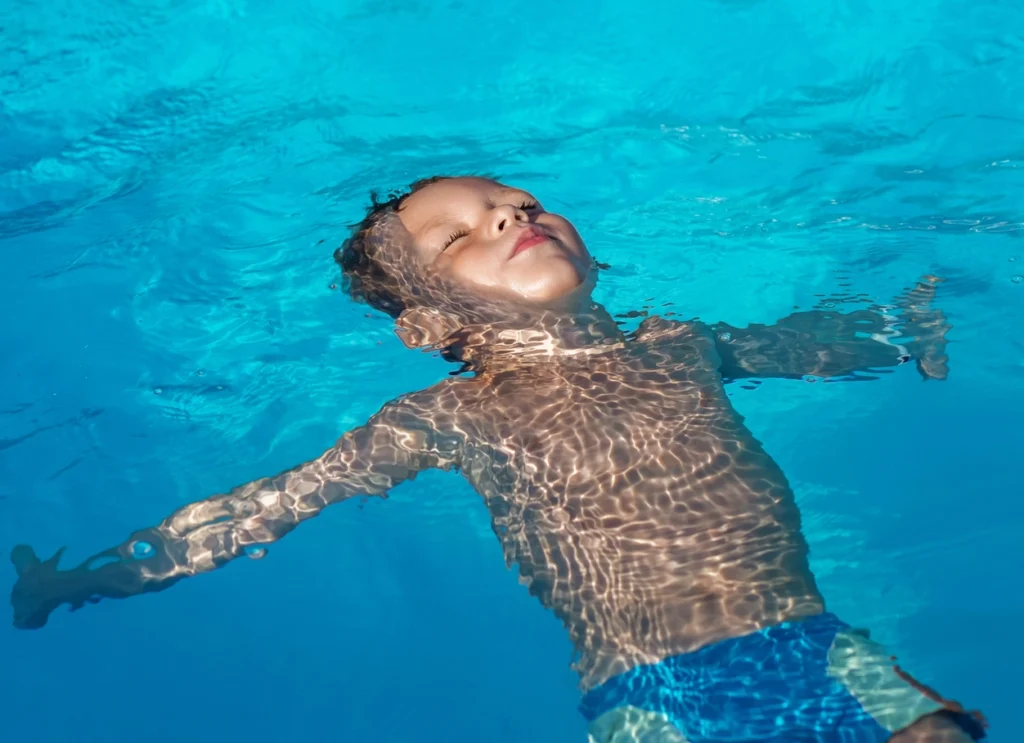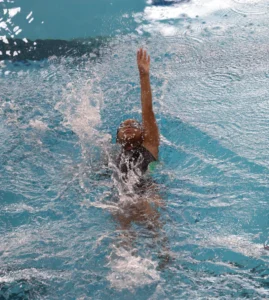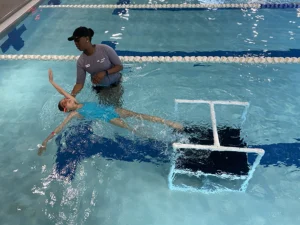Swimming and Meditation Go Hand-in-Hand
Life can get overwhelming. With so much information coming at us all day, and life’s busyness pushing us in many directions, it’s easy to feel mentally drained by the end of the day. So it’s no wonder many people are seeking ways to find peaceful moments each day.
Many people discover the solution in the gentle rhythm of swimming laps. What starts as a simple exercise often transforms into something much more powerful— a moving meditation that clears the mind in remarkable ways. At WeAquatics, we see it happen every day – swimmers arriving stressed and distracted, then leaving the pool with calm eyes and easy smiles.
How Swimming Naturally Creates a Meditative State

That feeling after a good swim— mental clarity and emotional calm—isn’t just in your imagination. There’s real science to show why swimming feels so therapeutic.
The Rhythm of Breath and Movement
What makes swimming so meditative comes down to three simple elements:
Breathing falls into a pattern – Just like in meditation, where controlled breathing anchors the practice, swimming requires breathing in a deliberate rhythm
Movements become repetitive – Each stroke repeats, creating a physical pattern that occupies the mind’s tendency to wander
The water creates a sensory retreat – Submerged in water, external noises fade, phones are unreachable, and the gentle pressure surrounds the body completely
These elements work together to naturally guide swimmers into what’s known as a “flow state” – when a person is completely present, worries temporarily suspended, focused only on the moment and movement.
Is Swimming a Form of Meditation?
Swimming is absolutely a form of meditation! This method of meditation works best for people who have trouble sitting still. Swimming offers a different path to the same mental benefits. Experts call it “moving meditation” – finding mental stillness through rhythmic physical activity.
This transformation happens regularly at pools across the DMV area. A study published in Brain Sciences confirms this observation – aquatic activities significantly improve psychological wellbeing and overall mental health outcomes.
What makes swimming unique from running or cycling is the complete sensory experience. The water’s buoyancy supports the body while providing gentle resistance. The sound changes underwater, creating a natural sound barrier from the outside world. Even the sensation of water against skin provides a constant, gentle reminder to stay present.
The Science Behind Swimming as Meditation
The mental benefits of swimming aren’t just subjective experiences – they’re supported by solid research.
Measurable Mood Improvements
When researchers studied 100 college students who swam regularly, they found something remarkable. After just one swimming session, participants reported significant drops in tension, depression, anger, and confusion.
The benefits appeared regardless of swimming ability— both beginners and experienced swimmers felt better after their swim.
Anxiety Reduction and Stress Relief
For those in the high-pressure DMV environment, the anxiety-reducing effects of swimming can be particularly valuable. A comprehensive analysis combining multiple studies found that aquatic exercise significantly reduces symptoms of anxiety and mood disorders.
The Neuroscience of Swimming and Meditation
When we dive deeper into the neuroscience, swimming’s meditative effects become even more fascinating.
The “Blue Mind” Effect
Marine biologist Wallace J. Nichols coined “Blue Mind” to describe the mildly meditative state characterized by calmness, peacefulness, and a sense of general happiness associated with water.
This state is linked with:
- Reduced cortisol (stress hormone) levels
- Increased release of dopamine, serotonin, and oxytocin
- Activation of the parasympathetic nervous system (rest and digest mode)
Altered Brain Activity
A case study examining a competitive swimmer’s brain activity showed significant changes in brain waves after implementing mindfulness techniques during swimming. Specifically, researchers observed increased Sensory Motor Rhythm (SMR), Beta, and Beta 2 waves – patterns associated with focused attention and emotional regulation.
Swimming can actually change how our brains function, creating patterns similar to those observed during traditional meditation practices.
Swimming and Meditation: Techniques to Try
Ready to experience swimming as meditation? Here are some approaches to enhance the meditative aspects of your swim:
Mindful Stroke Counting
- Focus your attention on counting strokes between breaths
- When your mind wanders (and it will), gently bring it back to your count
- Observe how your stroke count changes as you fatigue or relax
Breath-Centered Swimming
- Make your breathing the focal point of your swim
- Notice the sensation of inhaling and exhaling
- Create a consistent breathing pattern that feels comfortable
- Sequentially focus attention on different parts of your body
- Notice the sensation of water against your skin
- Be aware of tension and consciously release it
Mantra Swimming
- Choose a simple word or phrase that resonates with you
- Repeat it in rhythm with your strokes
- Let the mantra anchor your attention when thoughts arise
These techniques transform a regular swim into a purposeful mindfulness practice, amplifying the mental benefits beyond what you’d get from swimming on autopilot.
Who Benefits Most from Swimming Meditation?
While swimming meditation benefits everyone, certain groups may find it particularly valuable:
High-Stress Professionals
For those working in government, policy, contracting, and other high-pressure DMV industries, swimming provides a complete mental reset. The immersive nature of water creates a rare disconnection from phones, emails, and the constant demands of professional life.
Individuals with Anxiety
Research shows that aquatic exercise may be especially effective in reducing anxiety symptoms. The combination of rhythmic breathing, repetitive movement, and the sensory experience of water creates a natural anxiety-reducing environment.
Those Who Struggle with Traditional Meditation
Many people find sitting meditation challenging – the stillness paradoxically makes mental chatter louder. Swimming offers an alternative path to mindfulness that engages the body while still allowing physical movement.
Parents and Caregivers
Those responsible for others often struggle to find moments of mental space. Swimming carves out dedicated time for self-care while also modeling healthy stress management for children and dependents.
Incorporating Swimming Meditation into Your Routine
Creating a sustainable swimming meditation practice is easier than you might think:
For Beginners
- Start with just 15-20 minutes of gentle swimming
- Focus on enjoying the sensation of water rather than distance or speed
- Choose quieter pool times when possible
- Consider taking Adult Learn-to-Swim classes to build comfort and skills
For Experienced Swimmers
- Dedicate portions of your existing workouts specifically to mindful swimming
- Experiment with different meditation techniques during different sets
- Try slowing down occasionally – research shows lower intensity swimming may have greater mental health benefits
- Consider joining our Adult Masters program for structured sessions with like-minded swimmers
Finding Your Swim Sanctuary at WeAquatics

Everyone deserves access to the physical and mental health benefits of swimming, as meditation. Whether you’re a beginner or an experienced swimmer who wants to get back into the swing of things, our programs provide incredible opportunities for swimmers of all ages and stages to discover for themselves how swimming can improve their minds.
Are you ready to dive into the mental health benefits of swimming? Connect with us today to learn more about our programs across the DMV area— your body and mind will thank you!




